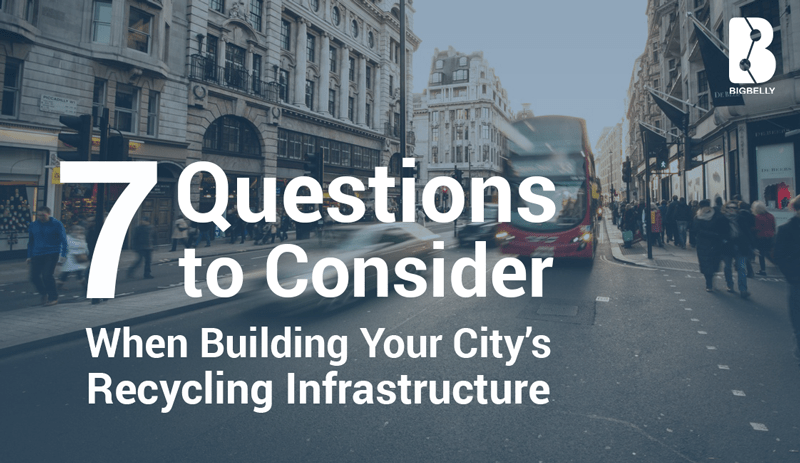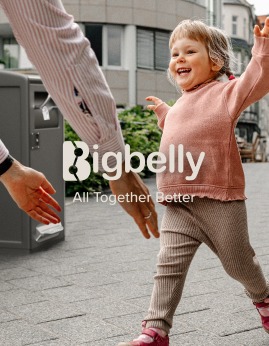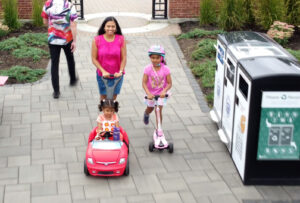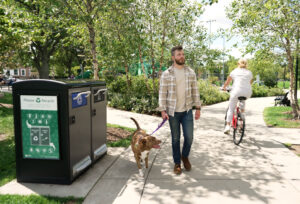
Waste collection and recycling infrastructures are vastly different. Successful recycling programs ensure that materials get recycled properly. Most municipalities have designed public space waste management without a great deal of focus on recycling or ensuring that materials can be recycled. Recycling collection infrastructures are designed to keep recyclable materials in marketable condition – free of contamination and comingling with trash. Cities have garbage collection processes that prevent litter – windblown and overflow – in public spaces but not all have comprehensive public recycling programs.
The long-term success of a community’s public space recycling program entails a lot more than just putting new recycling bins in public spaces. It requires careful consideration in building the recycling collection infrastructure, which starts by identifying the current waste collection infrastructure – how garbage is collected, what equipment is used and what processes are in place. This will help determine how best to incorporate recycling.
What components make up a public space recycling collection infrastructure?
There are components that play a key role in designing the system and the infrastructure, and policies, like bottle bills or pay-for-throw trash, that influence recycling program success and encourage more recycling. Common components to consider include:
- Containers – Type and Location (areas frequented by the public, where recyclable materials are generated)
- Education – Explain what materials are accepted in which recycling containers
- Collection
- Outsource or use of city services
- Monitoring progress – Track the gathering and transporting of materials to evaluate the effectiveness of the program
- Transportation – Determine how materials are transported from containers to holding areas, and whether specialized vehicles are needed
- Storage – Length and Location of storage to optimize trips to processing facilities
- Processing – Methods for sorting and condensing materials to be sold to end market
- End Market – Determine which recyclables are in demand for making new products
What infrastructure exists for collecting waste?
It is best to consider all options completely before making a decision – building recycling on top of an existing trash collection infrastructure vs. building an entirely new recycling infrastructure, which is cost prohibitive for most cities. Municipalities need to look at waste and recycling infrastructures as a whole system to determine what to modify and what to create new.
Will the recycling program require different trucks, dumpsters, and facilities than those required for waste collection?
Working within a garbage infrastructure by altering the current garbage system can appear easier and most cost effective. Cities avoid an upfront investment in new equipment, different containers, and a shift in operations. In actuality, garbage infrastructures are confining. They force cities to use containers, collection and transportation methods designed for garbage, which are often inappropriate for recycling.
What are the program’s goals and measures of success?
Reporting, especially if cities contract with a hauler to pick up recycling from individual containers, is essential to know just how effective the program is. Data and information needed includes:
- Amount of recyclables collected
- Contamination levels by container or location
- Customer service levels
- Installation of new containers in locations convenient for the public
- Labeling and education
- Route information (which containers are serviced and when)
- Servicing of contaminated containers
How does a city determine what recyclable materials to collect?
Most cities will conduct a baseline study to determine the most commonly recycled materials. Some of the methods used to determine these materials are waste sorts, visual audits, and information gathered directly from waste collectors. These collections provide valuable insight and can determine materials that need to be diverted.
What containers should a city use for recyclables?
Recycling receptacles require more effort than simply placing them around your city. Educating the public on how to use your containers is essential. With an educational program in place, ensure that your containers areas convenient as trash containers
- Easily distinguished from trash containers
- Consistent in visual appearance
- Designed with restricted openings
- Easily and regularly serviced
How do you support long-term development of the program – costs, resources needed, maintenance, public support, and environmental impact?
In an ideal world, cities pair every trashcan with a recycling container. Some communities consider a phasing-in approach that entails fewer well-designed containers that:
- Allow for long-term budgeting
- Make monitoring and servicing easier
- Make the initial investment relatively more manageable
- Maximize container use
- Provide maintenance staff with the time needed to work through transition challenges
By taking these seven considerations into account, your city can establish a stronger infrastructure to support a sustainable recycling program. Let us know if you have any feedback about additional questions you think are important to ponder before implementing a recycling program in your city. We would love to hear from you!



